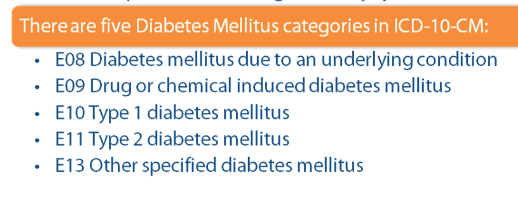Diabetes ICD-10 Medical Coding Guidelines: Everything You Need to Know
- MedicalCodingbyJen

- Mar 2, 2023
- 3 min read
# 1 Jen Tip to remember is the ICD 10 codes are COMBINATION CODES!

Type. 2. Body system. 3. Complication ALL IN ONE CODE
Next, diabetes is a chronic disease that affects millions of people worldwide. There are different types of diabetes, including type 1, type 2, and gestational diabetes. Each type has its own ICD-10 code, and it is important to use the correct code to ensure accurate documentation and billing. Here are some of the diabetes ICD-10 codes and guidelines:
Type 1 diabetes
Type 1 diabetes is an autoimmune disease that occurs when the body's immune system attacks the pancreas, which produces insulin. The ICD-10 code for type 1 diabetes is E10, and it is further classified based on the presence of complications such as diabetic ketoacidosis (DKA) or hypoglycemia. The ICD-10 codes for type 1 diabetes with DKA are E10.1 and E10.9, while the code for type 1 diabetes with hypoglycemia is E10.641.
Copies of my ICD10 Diabetes notes can be found here https://www.medicalcodingbyjen.com/product-page/diabetes-guideline-example-book-prep

Type 2 diabetes
Type 2 diabetes is a metabolic disorder that occurs when the body cannot properly use insulin or does not produce enough insulin. The ICD-10 code for type 2 diabetes is E11, and it is further classified based on the presence of complications such as retinopathy, neuropathy, or nephropathy. The ICD-10 codes for type 2 diabetes with retinopathy are E11.3 and E11.36, while the code for type 2 diabetes with neuropathy is E11.42, and the code for type 2 diabetes with nephropathy is E11.21.
Gestational diabetes
Gestational diabetes is a type of diabetes that occurs during pregnancy. The ICD-10 code for gestational diabetes is O24.4, and it is further classified based on the presence of complications such as pre-existing diabetes or hyperglycemia. The ICD-10 codes for gestational diabetes with pre-existing diabetes are O24.4-1 and O24.4-9, while the code for gestational diabetes with hyperglycemia is O24.4-2.
Causal Relationships of DM
A causal relationship is assumed between codes linked in the Alphabetic Index with the word “with,” which implies associated with or due to. Provider documentation does not have to state the conditions are related for you to assign these codes. However, if the provider specifically documents that the two conditions are unrelated, the codes linking the two cannot be assigned. Example: If a patient has type 2 diabetes and chronic kidney disease (CKD), and the provider has not stated they are unrelated, it would be appropriate to report code E11.22 Type 2 diabetes mellitus with diabetic chronic kidney disease.
It is essential to follow the ICD-10 coding guidelines when documenting and billing for diabetes. Using the correct codes and including any necessary modifiers can help ensure accurate reimbursement and prevent claim denials. In addition, healthcare providers should also document any relevant symptoms, signs, and laboratory findings to support the diagnosis and code selection.
Jen Tips -E11 is DEFAULT! E08-E09 = 2nd code in sequences! E10 NO Z79!
If you want more information by video on these guidelines, I have one short video and one long video posted for free. I hope they help. Just click the links.
In conclusion, diabetes ICD-10 coding guidelines are essential for accurately documenting and billing for diabetes. Understanding the correct codes and modifiers can help ensure that healthcare providers receive proper reimbursement and prevent claim denials. Healthcare providers should also document any relevant symptoms, signs, and laboratory findings to support the diagnosis and code selection. To learn more about diabetes ICD-10 coding guidelines, you can visit the Centers for Medicare & Medicaid Services website (CMS) or consult with a certified medical coder.
References:
Centers for Medicare & Medicaid Services. (2022). ICD-10-CM Official Guidelines for Coding and Reporting. Retrieved from https://www.cms.gov/files/document/2022-icd-10-c






Comments